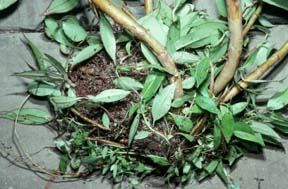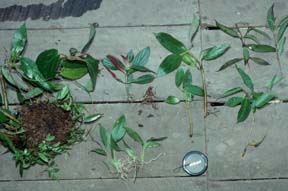= Pheidole JTL-074
Formicidae, Hymenoptera, Insecta, Arthropoda, Animalia
Identification
Minor worker: head length 0.78mm, head width 0.62mm, scape length 1.02mm, Webers length 0.97mm (n=1). Head evenly rounded behind, without vertex collar; promesonotal and metanotal grooves well impressed; propodeal spines long; face, pronotum, and dorsal mesosoma sculpture variable, from smooth and shiny to faintly and irregularly foveolate; mesosoma foveolate on sides; propodeum foveolate on sides and dorsum; gaster smooth and shiny; pilosity moderately abundant, long, flexuous; color red brown, with violaceous reflections in certain lighting.
Major worker: head length 1.27mm, head width 1.20mm, scape length 1.09mm (n=1). Face punctatorugose almost throughout, fading to smooth and shiny on vertex lobes; hypostomal margin with pair of widely-spaced teeth, each tooth sharp, subtriangular, located very near and partially overlapping recessed tooth flanking mandible; dorsal pilosity abundant, long, erect, flexuous; abundant suberect setae projecting from sides of head in face view.
Range
Costa Rica: upper elevation Cordillera de Tilaran, on Atlantic slope.
Natural History


This species is known only from the Penas Blancas Valley. It nests in discrete globular ant gardens.
Selected Records
Penas Blancas Valley (Germans): wet forest clearing; carton/soil fiorii-like nest on low vegetation. Polydomous, with one nest enveloping stems of shrub, second nest less than 1m away on underside of Xanthosoma leaf. First nest was covered with small dicot seedlings, all at the cotyledon stage.
Penas Blancas Valley (Germans): Wet forest clearing. A well-developed ant garden in front of house, with large epiphytes (figures). Nest about half the size of a soccer ball, discrete and irregularly spherical, on stem of Urera (Urticac.). Epiphytes from garden included: Blakea (Melastome), Columnea (Gesneriac.), Anthurium (Arac.), Coussapoa (Cecropiac.), Ficus (Morac.). I later saw several more of these ant gardens, with the same Pheidole and the same epiphytes. Plant ID's by Eric Bello. Additional notes from Bill Haber: The Coussapoa is possibly a species distinct from the common species in the area. The Gesneriac. is Columnea verrecunda, and he noted that there appear to be two tiny glands on the stem between each leaf pair. The Ficus looks like F. pertusa, except that it has little white dots all over the leaf. The leaves of the Blakea have a very pronounced pair of domatia, like mite domatia, on each side of the midrib near the center. Haber collection numbers for these plants: Columnea #10701, Anthurium #10702, Ficus #10703, Blakea #10704, Coussapoa #10705.
Penas Blancas Valley (Germans): ants in recent treefall.
Page authors:
John T. Longino, The Evergreen State College, Olympia WA 98505 USA. longinoj@evergreen.edu
Stefan Cover, Museum of Comparative Zoology, Harvard University, Cambridge MA 02138 USA. scover@oeb.harvard.edu